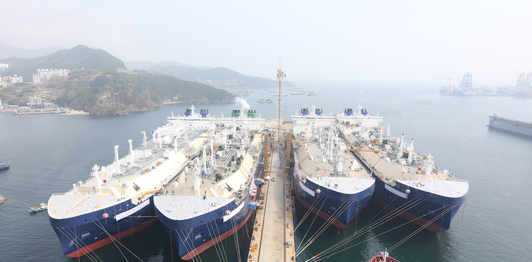
In the shipbuilding industry, LNG carriers are a representative field that creates large added value. Until the 1990s, Japan led the LNG carrier market, but Korea participated and beat Japan to lead the LNG carrier market through continuous technology development.
Currently, natural gas is in the spotlight as clean energy in the global energy market, and its consumption is soaring by an average of 3.2 percent per year. Except in the United States and parts of Europe, where gas is supplied through natural gas transportation pipes, natural gas supply is generally made through ships, and the LNG carrier market is expected to continue to expand. In addition, LNG production costs have plunged due to the development of technology to liquefy natural gas, and sales costs are rising as demand increases, accelerating the expansion of the LNG carrier market.
Due to this background, the development of LNG carriers in the 2000s can be largely divided into large-scale and development of various propulsion systems. In particular, the size of LNG carriers has been increased as demand for LNG has been centered on Far East Asia so far, but LNG demand has been newly created in the United States and Europe. This enlargement requires the safety of cargo windows and various propulsion systems are developing in connection with the operating economy of LNG carriers.
In 1975, the LNG carrier was about 30,000m3, but in the 1980s, it was enlarged to 125,000m3, and in the 1990s, 138,000m3 was built as a standard type. As demand in the U.S. and Europe increased, orders were placed up to 260,000 square meters in the 2000s, following 150,000 square meters and 200,000 square meters, which will open the era of mass transport of LNG using ships in the future.

Linear development of LNG carriers, cargo window sloshing and insulation box development, structural fatigue analysis, and technology development for new propulsion systems are very active, and Korean shipyards are leading these technologies. In the technology development of LNG carriers, the most important goal is to reduce transportation costs by considering the issue of increasing the operating economy, which is consistent with the goal of maximizing profits from the shipowner’s point of view.
To achieve this goal, Korea has developed a new dual fuel electric propulsion system that selectively uses two fuels and has now been adopted as the standard for economic propulsion systems in the medium (138K-155K) LNG carrier market. In addition, it can be said that it is most effective to reduce the cost of operating time through enlargement in order to increase the operating economy. However, there are many challenges that cannot be overcome only with medium-sized LNG carrier technology, so it has not been easy to achieve enlargement. The super-large LNG carrier is a groundbreaking product that has achieved rapid technological development by reflecting the shipowner’s requirements in development.
TED PARK
ASIA JOURNAL



